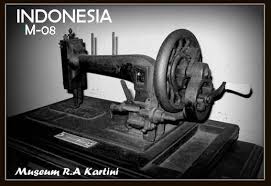In the last trip to Indonesia we had the opportunity to know the work of Ima Novilasari (1991, Blitar, Indonesia), who studied at the School of Art and Design of Surakarta. An artist/craftswoman who, although young, has a long experience in the field of tapestry, has developed among others a collaborative work with husbands and mothers “Visualization of the meaning of kinship through the Tapestry”, a work that shows that during work in the group elaboration of tapestries other values arise, and something that began as a collaboration with her husband serves to encourage mutual care, understanding and cooperation, and appreciate the meaning of the family at work. Ima Novilasari says “my husband is a basic sculptor who does not understand the tapestry, what must be done with total patience, thoroughness and fighting against boredom”. It is a woman who lives very different circumstances than a woman lives in the West, since she married only 24 years old, soon became pregnant and was forced to stop working, but unexpectedly obtained a collaboration project with the painter Edi Sunaryo to make a 2 x 5 meter tapestry. It was in that job, and as a result of her pregnancy, that her husband began to collaborate with her. In that work he adopted as inspiration the tree Kalpataru/Fertility of Edi Sunaryo. “The problems I feel for the pain, maybe also experienced by each person in the family. I will elevate the symbols of kinship and fertility as a form of awareness of the natural balance of each as husband and wife in carrying out the domestic ship” [www.ciptamedia.or.id/hibahcme/447]
On the other hand, the work of Ima Novilasari is not the result only of a personal reflection more or less formed, but it sinks its roots in a deep scientific investigation “Use of the thought of Kartini in the making of the tapestries” (published in the magazine Orn@men [Ornament] Vol. 12, No. 1, 2015). Kartini, another woman, proposes combating feudalism and defending emancipation, and the application of this thought is formalized in a work of exploration of forms. The feminine forms are subjected to processes of stylization (enrichment of the forms), distortion (representation of forms that emphasizes the achievement of the characters) and deformation (representing forms that emphasize the interpretation of the characters). Kartini has a museum dedicated to her in Rembang, and in it, it is easy to appreciate, in a visual and plastic way, the relationships between her thinking, the machinization of textile work, and the possibilities that this has historically offered to the autonomy of the woman.

These notes seek to illustrate the universality of textile art, whose basic defining characteristics have been magnificently explained in the text prepared by LABi, a group of students of the Master’s Degree in Photography, Art and Technique of the Polytechnic University of Valencia, on the occasion of the exhibition “Feminist Plots”. “Their learning model, in most cases without a formal education, and based on oral transmission, crosses cultures and worldviews, subverting the validated structure of knowledge as well as borders, extending from the west to the east and from north to south”.





